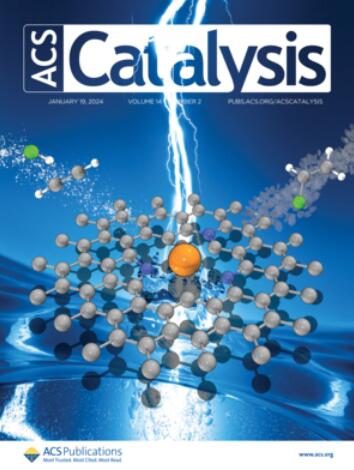Enhanced Photocatalytic Conversion of CO2 by H2O over Ag@Cr Cocatalyst-Modified ZnTa2O6
IF 11.3
1区 化学
Q1 CHEMISTRY, PHYSICAL
引用次数: 0
Abstract
A zinc tantalate (ZnTa2O6) photocatalyst modified with an Ag cocatalyst via ultrasonic reduction (denoted as Ag(USR)/ZnTa2O6) exhibited higher activity for the photocatalytic conversion of CO2 by H2O than Ag/ZnTa2O6 prepared by other widely used methods. However, the CO formation rate was low. In this study, a photocatalyst was prepared by coating the Ag nanoparticles of Ag(USR)/ZnTa2O6 with Cr(OH)3·xH2O via the photodeposition (PD) method (denoted as Cr(PD)/Ag(USR)/ZnTa2O6) to increase the CO formation rate. Cr(PD)/Ag(USR)/ZnTa2O6 produced CO at the maximum formation rate of ∼600 μmol h–1, which was 50 and 8.5 times higher than those of bare ZnTa2O6 and Ag(USR)/ZnTa2O6, respectively. Furthermore, an induction period was observed during the time course of photocatalytic activity. The scanning electron microscopy images highlighted that Ag nanoparticles migrate to a specific site on the surface of ZnTa2O6 as photoirradiation proceeded, causing the rearrangement of Ag nanoparticles during this period. This rearrangement caused the separation of the photocatalytic reaction field, achieving high activity toward the photocatalytic conversion of CO2 because of the efficient reduction and oxidation reactions. Moreover, inductively coupled plasma mass spectrometry and ultraviolet–visible absorption spectroscopy revealed that Cr3+ in Cr(PD)/Ag(USR)/ZnTa2O6 is oxidized to dissolvable CrO42– during the induction period. These CrO42– anions in solution were found to play a crucial role in maintaining the Cr layer of Cr(PD)/Ag(USR)/ZnTa2O6.

求助全文
约1分钟内获得全文
求助全文
来源期刊

ACS Catalysis
CHEMISTRY, PHYSICAL-
CiteScore
20.80
自引率
6.20%
发文量
1253
审稿时长
1.5 months
期刊介绍:
ACS Catalysis is an esteemed journal that publishes original research in the fields of heterogeneous catalysis, molecular catalysis, and biocatalysis. It offers broad coverage across diverse areas such as life sciences, organometallics and synthesis, photochemistry and electrochemistry, drug discovery and synthesis, materials science, environmental protection, polymer discovery and synthesis, and energy and fuels.
The scope of the journal is to showcase innovative work in various aspects of catalysis. This includes new reactions and novel synthetic approaches utilizing known catalysts, the discovery or modification of new catalysts, elucidation of catalytic mechanisms through cutting-edge investigations, practical enhancements of existing processes, as well as conceptual advances in the field. Contributions to ACS Catalysis can encompass both experimental and theoretical research focused on catalytic molecules, macromolecules, and materials that exhibit catalytic turnover.
 求助内容:
求助内容: 应助结果提醒方式:
应助结果提醒方式:


